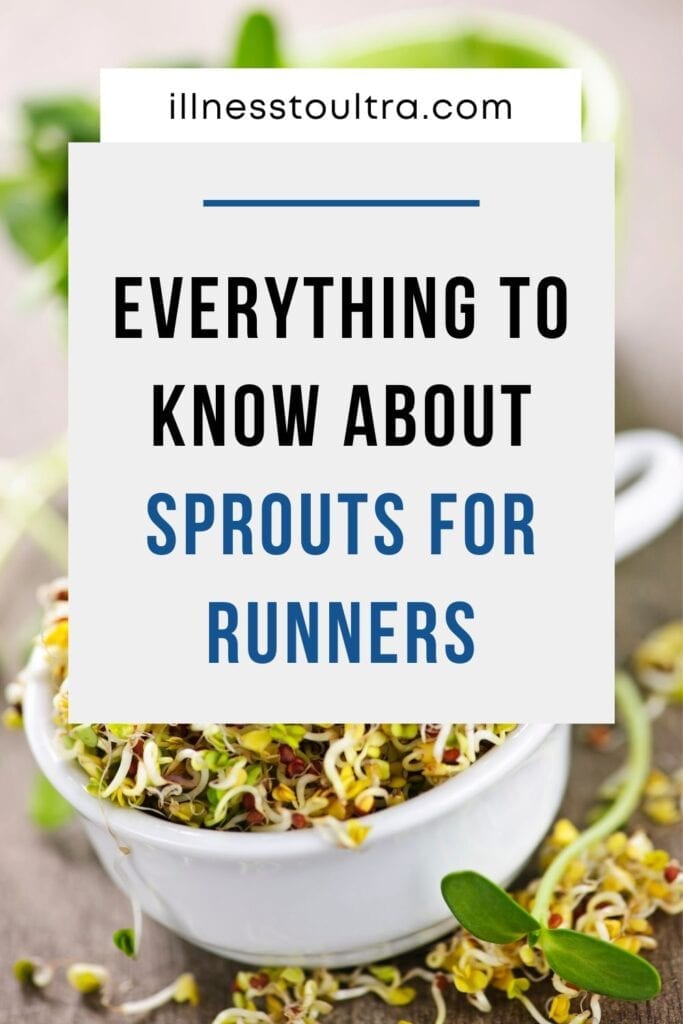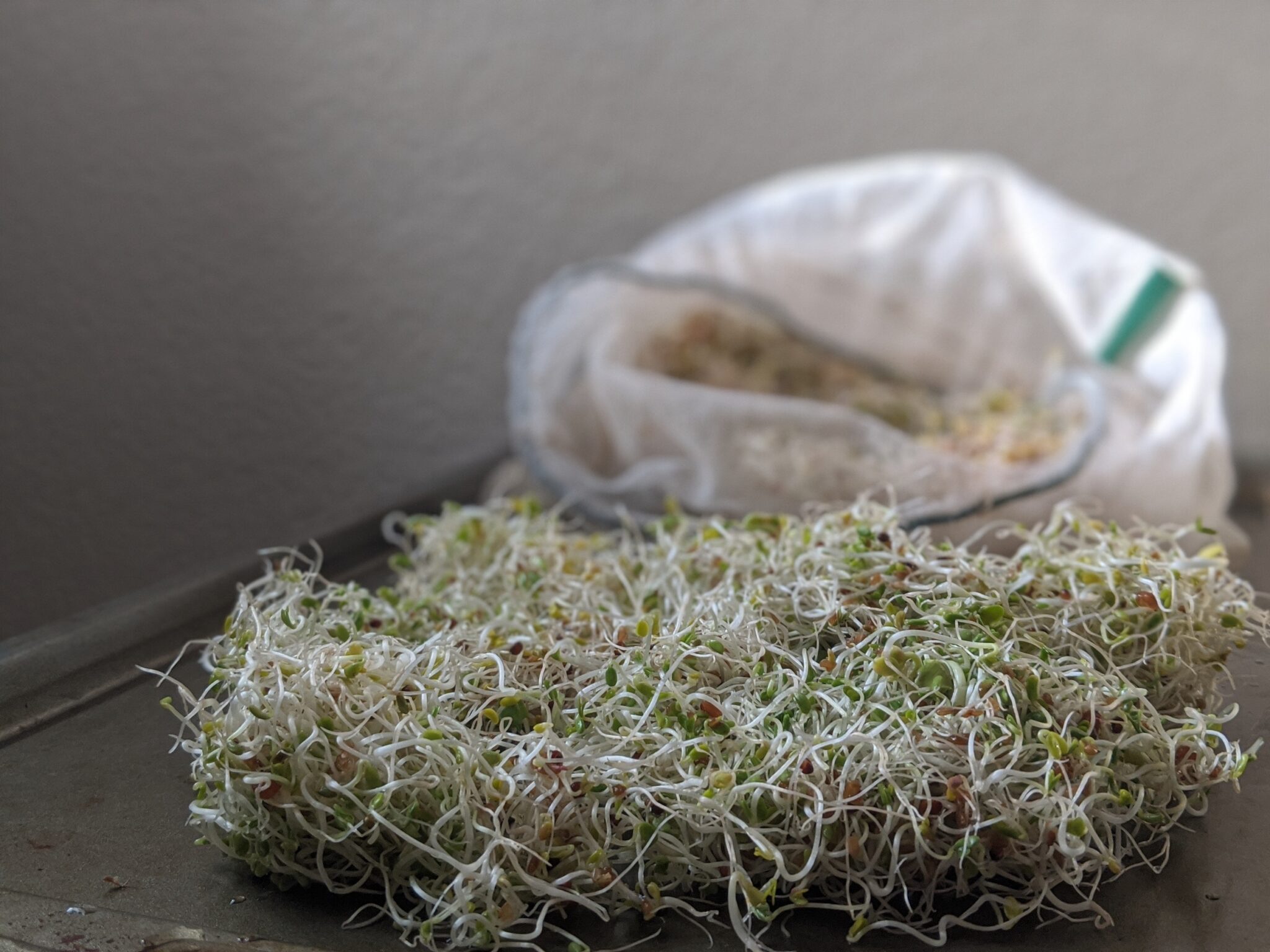And I’m not talking about the brussel sprouts that us British people over-consume at Christmas time. I want to talk about the tiny little plants that are barely alive when we eat them!
What are Sprouts?
Simply put, sprouts are plants in baby form.
They are the first signs of life that you see after the seed germinates. And that means that nearly any seed, nut, or grain can be sprouted to unlock a plethora of nutrients.
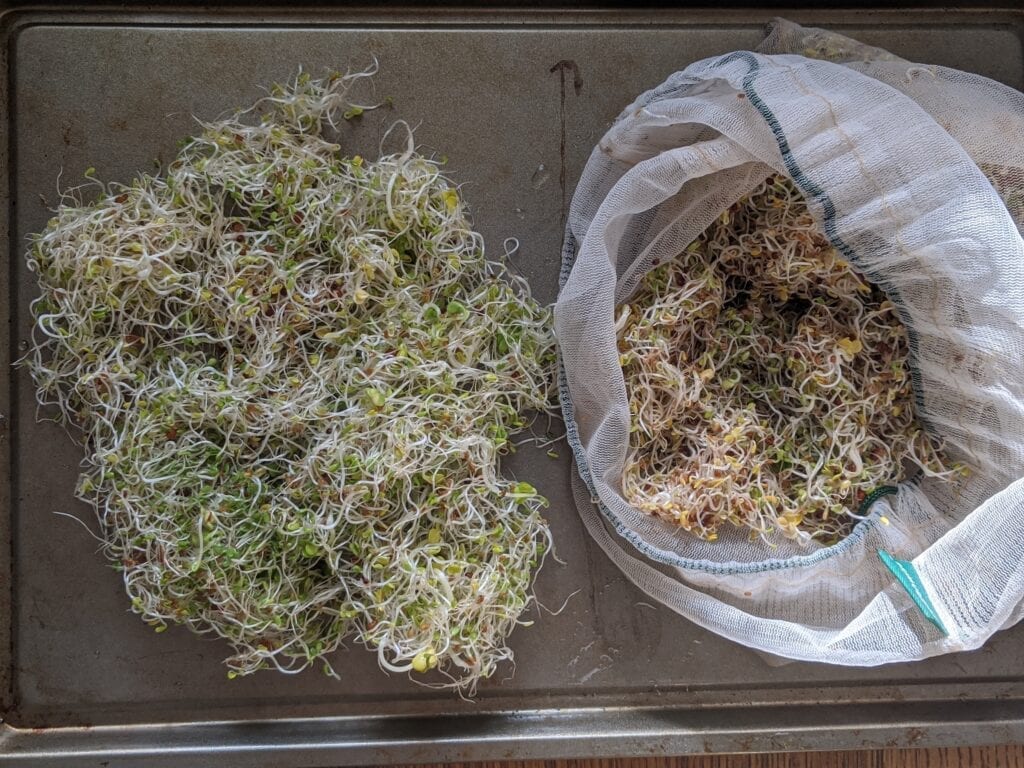
You can see some of my latest sprouts in action, tiny little seeds with a big tadpole-like tail shooting out of it. At some point, these will start to grow into deep green leaves, which is also another great time to consume plants. But how are these a running recovery food?
Don’t worry; I’ll tell the process of making these little beauties soon. But first…
Why Eat Sprouts?
Because they taste amazing……
Ok, that may not be true, sometimes they’re a little bitter, but that bitterness is a great indication that they’re going to work wonders for your body. Remember, most of the bitter tasting foods are usually the best for us.
As runners, we’re always looking for ways to recover faster, and that’s what I’m going to focus on in this post. When thinking about optimal recovery, we should immediately think about nutrition. So throw away that foam roller and just eat some sprouts. That’s sarcasm – don’t throw away your roller. But do eat sprouts.
Vitamins & Minerals
Let’s start simple. We all know we need vitamins and minerals for our bodies to survive, and we need them even more to recover faster from a run. So you’ll be happy to know that most plants’ vitamin content is at their highest in the sprouting phase.
Vitamin C
As a runner, you want to be looking at consuming higher amounts of vitamin C for many reasons. The number one reason is for immunity.
When you begin to get into high milage weeks, you are putting a large amount of strain on your body. When doing so, you are inhibiting your ability to fight off things like the common cold. Upping your Vitamin C intake helps inflammation and ensures healthy immune cell formation.
The vitamin C content of 1 cup of Kidney bean sprouts is roughly 60% of your recommended daily intake (RDI)! That’s close to the almighty orange for vitamin C content, and without the sugar hit affecting your gut.
Iron
Iron levels in runners are really important – especially in menstruating female runners. Iron is required for the formation of new red blood cells to help distribute oxygen around the body. When you are training in hot, high altitude climates, it’s common to lose minerals like iron via sweating, reducing the ability for you to recover and train at peak performance.
One cup of Chickpea sprouts holds 40% of your RDI of iron and a good dose of protein (I’ll come to that later).
Phytic Acid
One amazing benefit to sprouting is the reduction in Phytic Acid. Phytic acid, or phytate, is an anti-nutrient that inhibits the absorption of many minerals including, zinc, iron, and calcium. The reduction occurs because, during the sprouting process, the plant breaks down the phytic acid to initiate the new plant’s growth!
Soy that has been sprouted contains 56% less phytic acid. The study also mentioned that tofu was tastier when the soybean was sprouted. Just saying. 🙂
There are many more examples of high vitamin and mineral contents found in sprouts, so hopefully, this alone has convinced you to try them out. But rather than focusing on one type of sprout, I’d encourage you to consume a variety of all sprouts to reap a variety of nutritional benefits!
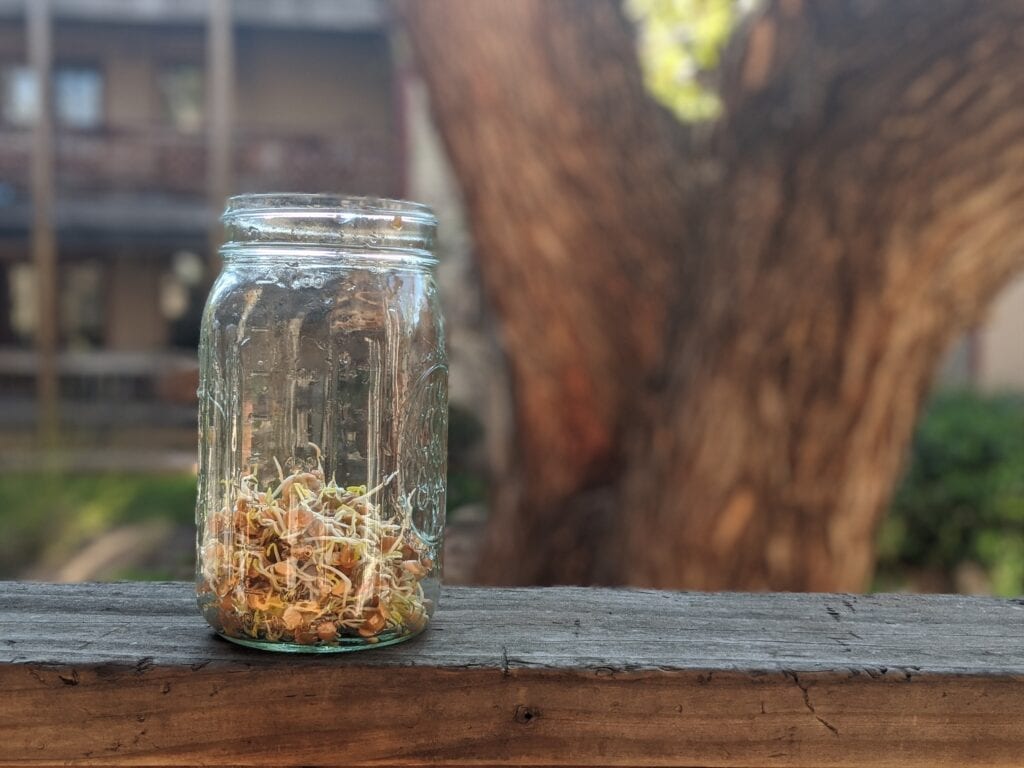
A great source of vegan protein
I hinted at this earlier; but sprouts can be a great source of vegan protein. Now, this is bound to get a little complicated, so I’ll try and make it as painless as possible.
Many studies have shown that vegan sources of protein are linked with longevity. The China Study probably being the most famous. And while I feel that a completely vegan diet isn’t great for everybody, reducing your consumption of animal-based products is generally a good idea.
Now here comes the issue for runners. Because we’re so active, it can be hard to consume the right amount of bio-diverse protein to maintain high-performance.
This isn’t because we can’t eat enough plant protein, that’s quite easy to do in today’s world with protein powders. However, because the vegan protein you eat is not usually in a form that is well absorbed, or inhibited by other factors of the plant, your digestive tract will be unable to break the protein down in the important amino-acids for absorption.
During the process of germination, proteins begin to break down into more absorbable forms of amino acids. That means that the sprouting process does all the work for your gut, causing less stress and maximum absorption! Sprouting could genuinely be the key to a high protein requirement for runners like you and me. We don’t need to eat more protein; we just eat predigested forms of protein to maximize efficiency.
An increased amount of Enzymes
We all require enzymes to break down food. Usually, our bodies provide most of the enzymes we need in various parts of the digestive tract to break down fats, proteins, and carbs.
Good news! Plants are here to help. You may have heard that pineapples and papayas have high enzyme counts that can help to break down other foods you consume. If you haven’t – well, now you have!
For even more good news! During the sprouting period, plants can have up to 100 times the amount of enzymes than their fully-grown counterparts.
That means that consuming sprouts will help with digesting any other foods you consume alongside them. Mixing sprouts with other superfoods and healthy plants can make a potent cocktail of goodness. Which is all important when trying to recover from heavy set of intervals, or tempo training.
Ok, I’m convinced. Now, where can I get them?
You can grow them yourself! And they’re cheap too!
You can pop down to your local health food store or even to the grocery store, and you’ll most likely find Alfalfa sprouts on the shelves ready to eat. But don’t stop there; you can gain a ton more benefits from consuming a variety of different sprouts like lentils, chickpeas, mung beans, peas, broccoli, chia, and more.
How to start sprouting
Once you have your sprout of choice, the next general steps are to:
- Soak
- Aerate
- Rinse multiple times per day
- Eat!
Now timing usually differs for each plant, so I’m going to take you through the process of producing Broccoli sprouts, a sprout known for its potent anti-oxidant effect.
Sprouting Times Cheat Sheet
Want to know how long soaking a chickpea takes?
What about sprouting flax seeds?
How many clover seeds do you need to make a cup of sprouts?
I put together a FREE cheat sheet for exactly those reasons. Print it out, stick it on your fridge, and get your timings right every attempt!
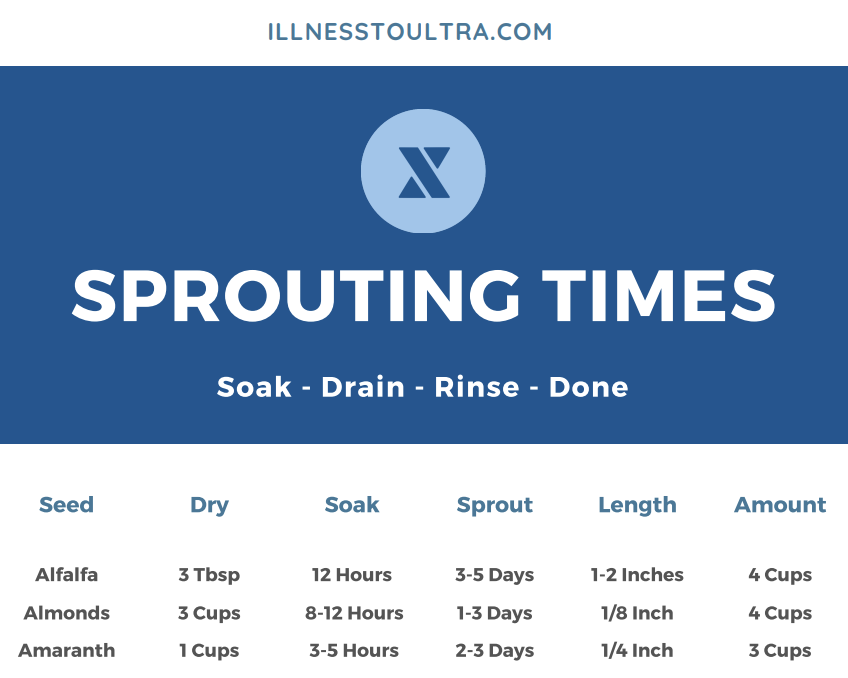
Soak
Once you’ve got some high-quality seeds ripe for sprouting, you’ll want to soak them. For Broccoli sprouts, you’ll want to let them soak for 8 – 10 hours in a warm dark place.
It’s best to do this overnight so you can move on to the next stage in the morning.
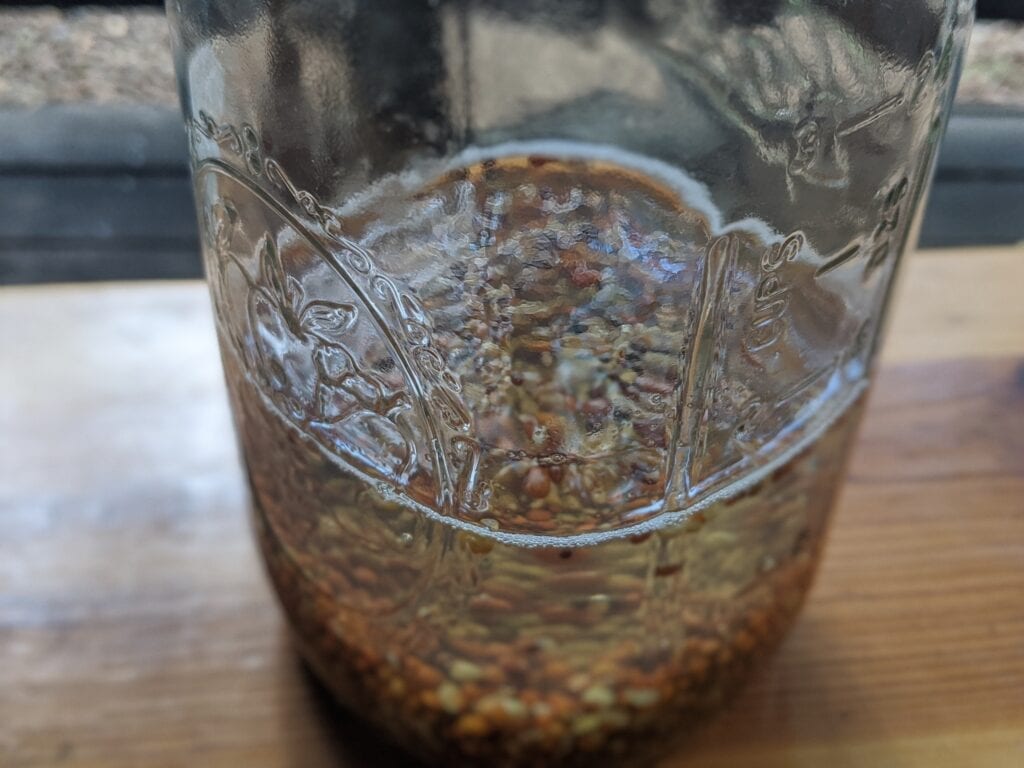
Rinse
After allowing the seeds to soak, you’ll want to rinse them off. The process of rinsing them off will deter any harmful bacteria from developing on the plants.
Drain
Drain all the water away and let them sit in that same warm dark place. Many will advise placing them in an inverted jar at a 45-degree angle with a cloth over the top to stop the seeds from falling out. Doing so will ensure all liquid drains away and further prevents the sprouts from spoiling.
You don’t need an expensive solution, I just slapped together jars and containers that we had around the kitchen and kept them at an angle.
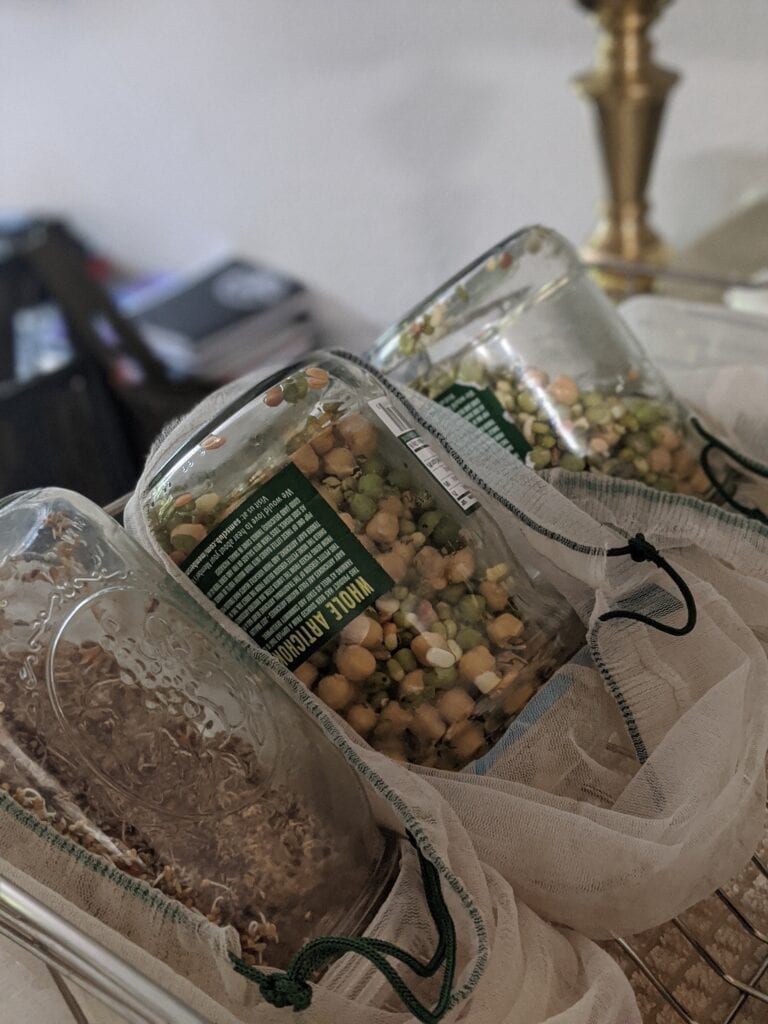
Repeat
Now repeat the rinse and drain process 2 to 3 times a day, for around 4-5 days. You’ll start to see the little tails appearing about 2 days in, and you’ll want to grow them until they’re around an inch long, or when you start to see a small yellowish leaf appear at the end of the shoot.
Unleash the sunlight
The plants have now started to form, so it’s time to harness the sun’s power. You’ll repeat the same rinse and drain process as before, which is even more important now to ensure they do not dry out.
The yellow leaves will start to turn green, and growth will be rapid. Keep an eye on them for the next two days. They’re pretty much done at around 2 inches long. But if you want a little taste early, you can do so when you start seeing the green leaf evolve.
That’s it. It’s like your own little plant project. Once you get used to it, the process will become a meditative ritual that you perform night and morning. The process is even more satisfactory when you consider the fact that you produced these nutrient powerhouses.
Sprouting Times Cheat Sheet
Want to know how long soaking a chickpea takes?
What about sprouting flax seeds?
How many clover seeds do you need to make a cup of sprouts?
I put together a FREE cheat sheet for exactly those reasons. Print it out, stick it on your fridge, and get your timings right every attempt!

What should I sprout?
Start simple and go with the broccoli sprouts I mentioned. They’re very easy as a starter sprout.
Once you get a little more confident, you can then start thinking about covering different nutrient bases like vitamins, proteins, and even fats. Here’s a list I’ve made to give you a head start.
- Green peas/Chickpeas/Lentils – Protein
- Broccoli/Alfalfa/Clover/Radish – Antioxidants/Vitamin C
- Chia/Flax/Almonds/Pecans – Fatty Acids
- Mung beans/Navy beans/Sunflower Seeds – B Vitamins
Note, the method of sprouting chia,flax and most nuts is slightly different, but I’ll leave that for a different day.
It’s now time to start a mini-farm in your kitchen! And don’t forget to get the kids involved, so they can become mini-farmers too!
Like it! Pin it!
